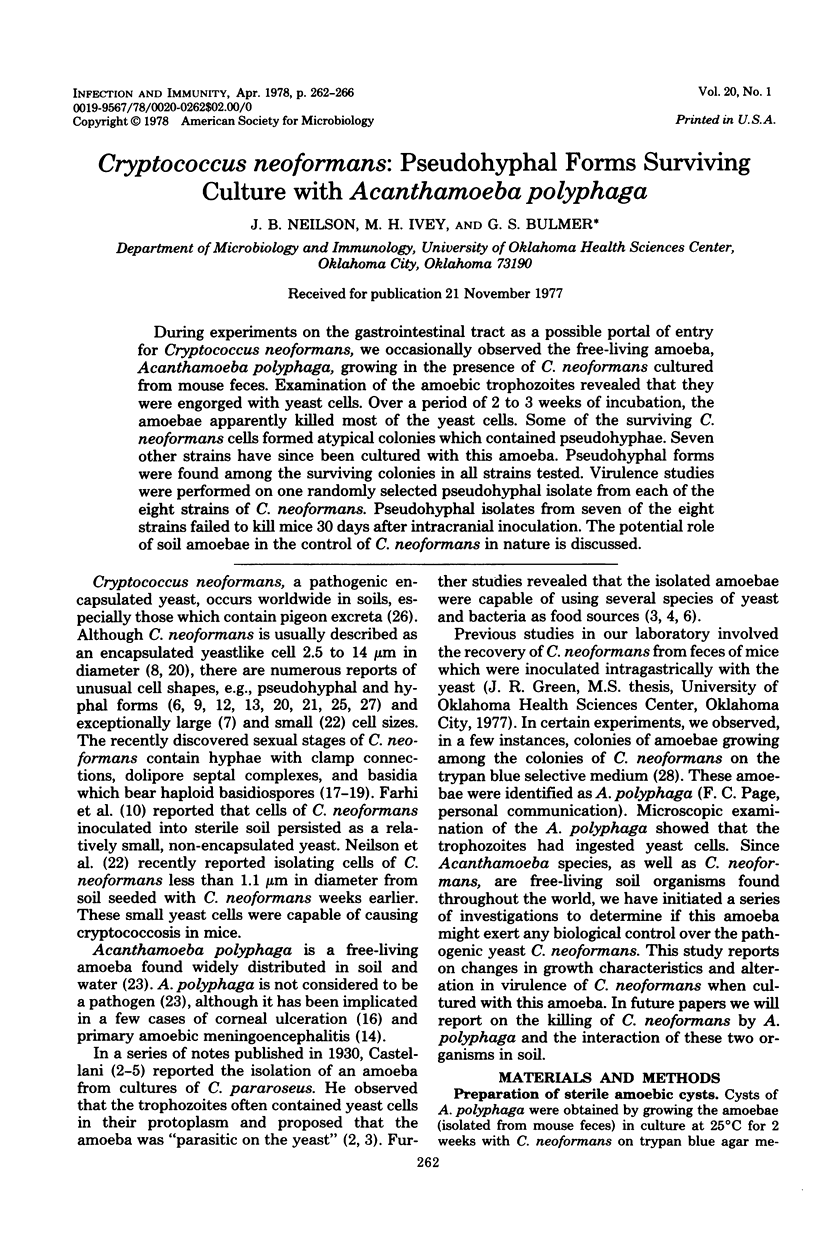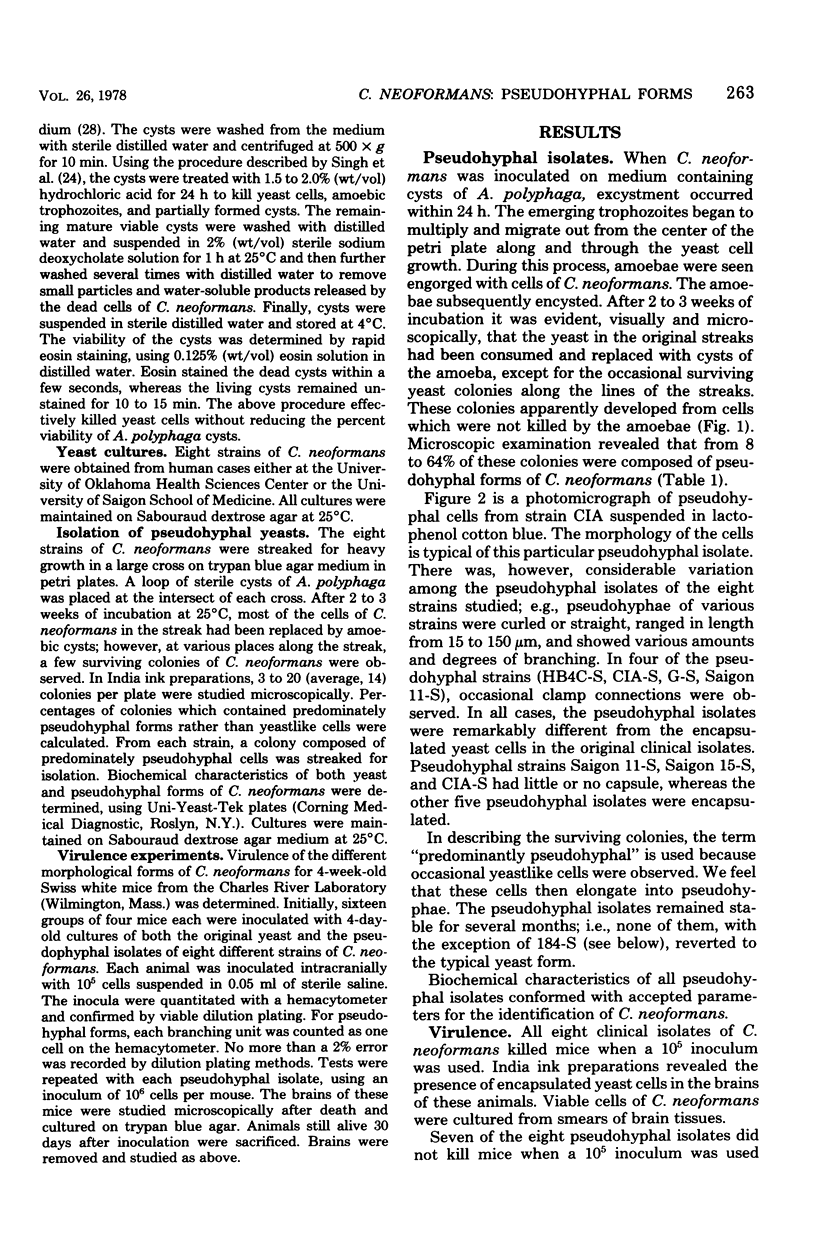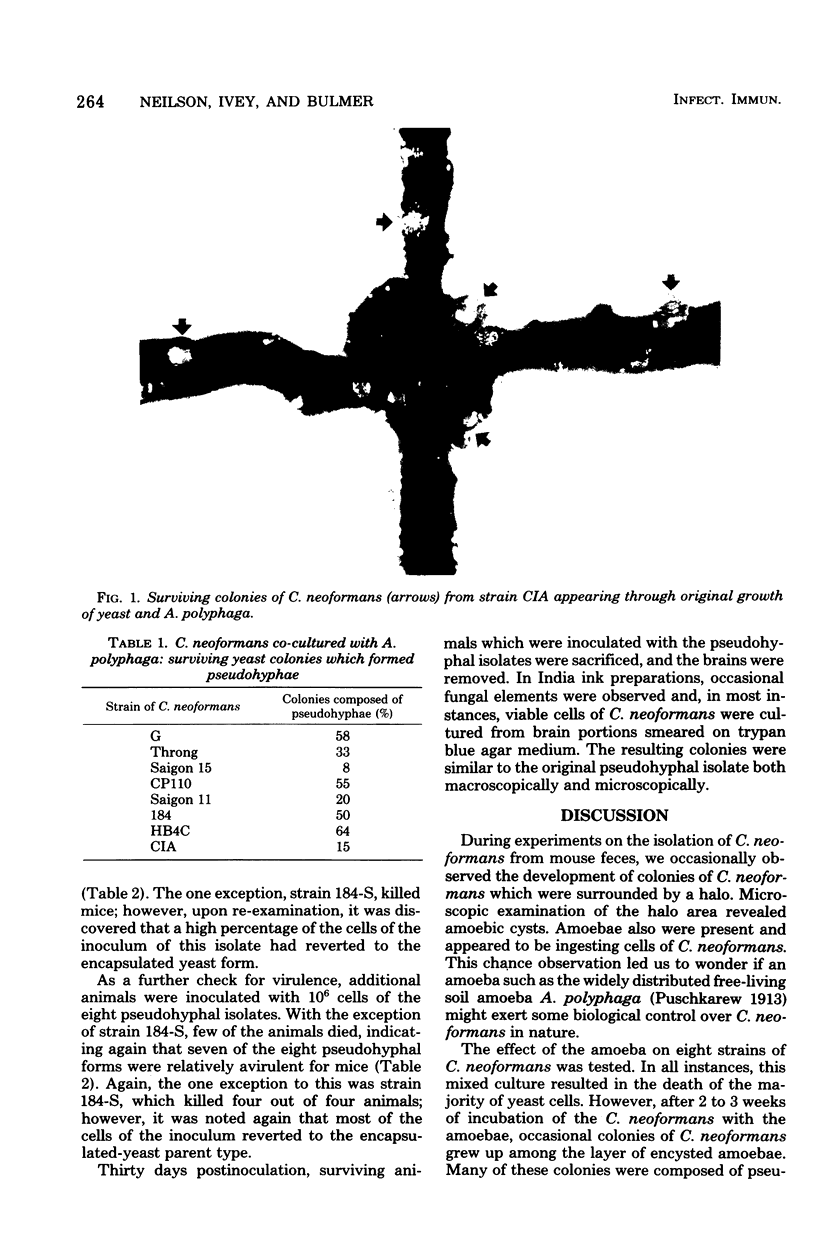Abstract
During experiments on the gastrointestinal tract as a possible portal of entry for Cryptococcus neoformans, we occasionally observed the free-living amoeba, Acanthamoeba polyphaga, growing in the presence of C. neoformans cultured from mouse feces. Examination of the amoebic trophozoites revealed that they were engorged with yeast cells. Over a period of 2 to 3 weeks of incubation, the amoebae apparently killed most of the yeast cells. Some of the surviving C. neoformans cells formed atypical colonies which contained pseudohyphae. Seven other strains have since been cultured with this amoeba. Pseudohyphal forms were found among the surviving colonies in all strains tested. Virulence studies were performed on one randomly selected pseudohyphal isolate from each of the eight strains of C. neoformans. Pseudohyphal isolates from seven of the eight strains failed to kill mice 30 days after intracranial inoculation. The potential role of soil amoebae in the control of C. neoformans in nature is discussed.
Full text
PDF




Images in this article
Selected References
These references are in PubMed. This may not be the complete list of references from this article.
- CASTELLANI A. Action phagocytaire et destructrice de Hartmanella castellanii (Amoeba castellanii) sur un champignon levuriforme encapsulé pathogène Torulopsis neoformans (Cryptococcus neoformans). Ann Inst Pasteur (Paris) 1955 Jul;89(1):1–7. [PubMed] [Google Scholar]
- Cruickshank J. G., Cavill R., Jelbert M. Cryptococcus neoformans of unusual morphology. Appl Microbiol. 1973 Feb;25(2):309–312. doi: 10.1128/am.25.2.309-312.1973. [DOI] [PMC free article] [PubMed] [Google Scholar]
- Erke K. H. Light microscopy of basidia, basidiospores, and nuclei in spores and hyphae of Filobasidiella neoformans (Cryptococcus neoformans). J Bacteriol. 1976 Oct;128(1):445–455. doi: 10.1128/jb.128.1.445-455.1976. [DOI] [PMC free article] [PubMed] [Google Scholar]
- Farhi F., Bulmer G. S., Tacker J. R. Cryptococcus neoformans IV. The Not-So-Encapsulated Yeast. Infect Immun. 1970 Jun;1(6):526–531. doi: 10.1128/iai.1.6.526-531.1970. [DOI] [PMC free article] [PubMed] [Google Scholar]
- Felton F. G., Muchmore H. G., McCarty M. A. Epidemiology of cryptococcosis: I. Environmental distribution of cryptococci in Oklahoma. Health Lab Sci. 1974 Jul;11(3):201–204. [PubMed] [Google Scholar]
- Freed E. R., Duma R. J., Shadomy H. J., Utz J. P. Meningoencephalitis due to hyphae-forming Cryptococcus neoformans. Am J Clin Pathol. 1971 Jan;55(1):30–33. doi: 10.1093/ajcp/55.1.30. [DOI] [PubMed] [Google Scholar]
- Gordon M. A., Devine J. Filamentation and endogenous sporulation in Cryptococcus neoformans. Sabouraudia. 1970 Nov;8(3):227–234. [PubMed] [Google Scholar]
- Griffin J. L. Temperature tolerance of pathogenic and nonpathogenic free-living amoebas. Science. 1972 Nov 24;178(4063):869–870. doi: 10.1126/science.178.4063.869. [DOI] [PubMed] [Google Scholar]
- Ishaq C. M., Bulmer G. S., Felton F. G. An evaluation of various environmental factors affecting the propagation of Cryptococcus neoformas. Mycopathol Mycol Appl. 1968 Jul 12;35(2):81–90. doi: 10.1007/BF02049570. [DOI] [PubMed] [Google Scholar]
- Jones D. B., Visvesvara G. S., Robinson N. M. Acanthamoeba polyphaga keratitis and Acenthamoeba uveitis associated with fatal meningoencephalitis. Trans Ophthalmol Soc U K. 1975 Jul;95(2):221–232. [PubMed] [Google Scholar]
- Kwon-Chung K. J. A new genus, filobasidiella, the perfect state of Cryptococcus neoformans. Mycologia. 1975 Nov-Dec;67(6):1197–1200. [PubMed] [Google Scholar]
- Kwon-Chung K. J. A new species of Filobasidiella, the sexual state of Cryptococcus neoformans B and C serotypes. Mycologia. 1976 Jul-Aug;68(4):943–946. [PubMed] [Google Scholar]
- Kwon-Chung K. J. Morphogenesis of Filobasidiella neoformans, the sexual state of Cryptococcus neoformans. Mycologia. 1976 Jul-Aug;68(4):821–833. [PubMed] [Google Scholar]
- Lurie H. I., Shadomy H. J. Morphological variations of a hypha-forming strain of Cryptococcus neoformans (Coward strain) in tissues of mice. Sabouraudia. 1971 Mar;9(1):10–14. doi: 10.1080/00362177185190041. [DOI] [PubMed] [Google Scholar]
- Neilson J. B., Fromtling R. A., Bulmer G. S. Cryptococcus neoformans: size range of infectious particles from aerosolized soil. Infect Immun. 1977 Sep;17(3):634–638. doi: 10.1128/iai.17.3.634-638.1977. [DOI] [PMC free article] [PubMed] [Google Scholar]
- SINGH B. N., SAXENA U., IYER S. S. PRODUCTION OF VIABLE STERILE CYSTS OF FREE-LIVING AMOEBAE & ROLE OF BACTERIA ON EXCYSTMENT. Indian J Exp Biol. 1965 Apr;3:110–112. [PubMed] [Google Scholar]
- Sawyer T. K., Visvesvara G. S., Harke B. A. Pathogenic amoebas from brackish and ocean sediments, with a description of Acanthamoeba hatchetti, n. sp. Science. 1977 Jun 17;196(4296):1324–1325. doi: 10.1126/science.867031. [DOI] [PubMed] [Google Scholar]
- Shadomy H. J., Utz J. P. Preliminary studies on a hyphaforming mutant of Cryptococcus neoformans. Mycologia. 1966 May-Jun;58(3):383–390. [PubMed] [Google Scholar]
- Vickers R. M., McElligott J. J., Jr, Rihs J. D., Postic B. Medium containing trypan blue and antibiotics for the detection of Cryptococcus neoformans in clinical samples. Appl Microbiol. 1974 Jan;27(1):38–42. doi: 10.1128/am.27.1.38-42.1974. [DOI] [PMC free article] [PubMed] [Google Scholar]




